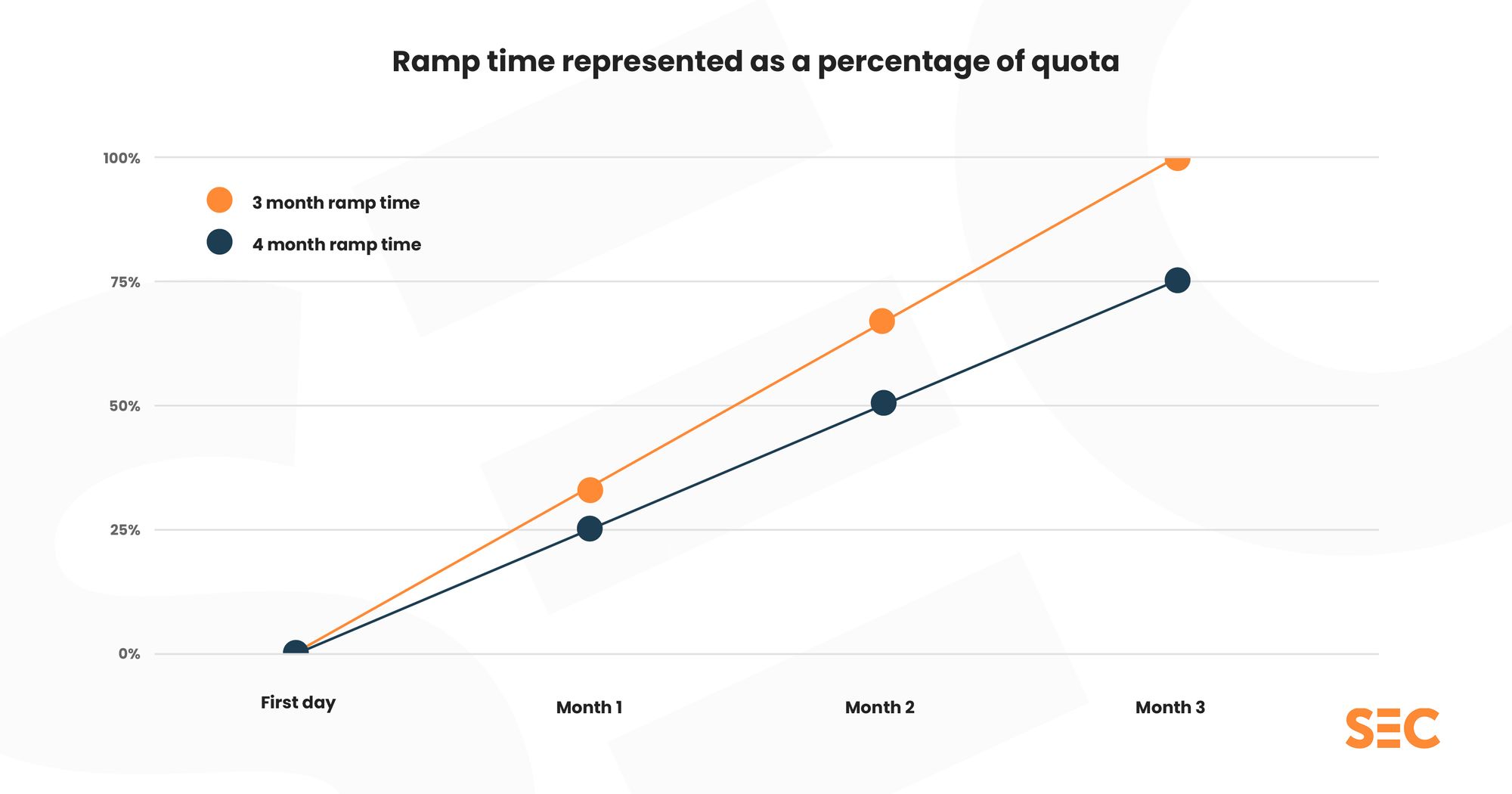There’s more to sales enablement than just numbers, but a well-designed sales enablement strategy should have a measurable impact on sales results and revenue.
The challenge is identifying and tracking the right metrics.
This will have to be a collaborative, cross-functional effort with your organization’s Sales Ops team as well as frontline sales managers.
While seeing improvements in many of the listed metrics will be an indication that your sales enablement efforts are working, they’re also a testament to the work of each individual rep and all those in the sales org.
Here’s a quick overview of key actions you can take:
- Align the sales team’s performance expectations with stakeholders to choose the most meaningful sales performance metrics.
- Establish performance milestones (monthly, quarterly, biannually etc.) and clarify how you plan to measure and report progress against the metrics as time goes on.
- Make sure everyone, from senior leadership, to managers and new hires, are on the same page in regards to what metrics mean.
Don’t overwhelm yourself - it’s often wise to concentrate on a smaller number of metrics initially. You can track more later on as needed - but some enablement experts believe that just tracking four or five key metrics is enough.
On the Sales Enablement Innovation podcast, Senior Director of Revenue Enablement Gail Behun had this to say:
The 21 sales metrics you must be measuring now
“I try to look at four or five at any given time consistently. I'd rather have fewer metrics that my team can look at and say: ‘This is what really matters”.
In this article, we’re going to look at:
- A run down of sales productivity metrics
- Leading indicators
- Lagging indicators
- Sales velocity
- What to do with the data
Let's dive right in. 👇

Sales productivity metrics
Measuring inputs as well as outputs is a good way to get a bird’s eye view of your sales team’s success (or lack thereof). Without having a few of both, it’s tough to analyze your organization’s journey towards achieving its sales goals.
Leading indicators cover everything that leads up to closing a sale, which can often give you an indication of how well your sales enablement inputs are impacting rep performance.
Leading indicators are essentially predictive. You’re looking at sales activities and using those to predict future success.
Examples include:
- Time to productivity
- Available selling time
- Content usage
- Sales confidence
- Number of activities
- Sales stage conversion rate
Meanwhile, lagging indicators measure the outputs after the fact - ie, the actual results.
For example:
- Win/close rates
- Quota attainment
- Customer churn rates
Some may argue that these are more sales KPIs than sales enablement metrics, but enablement’s influence can be felt throughout the sales process so they’re worth keeping an eye on.
It’s important to remember that just looking at the more obvious, lagging indicators isn’t good enough because by the time you have that data, it’s too late to intervene and improve the numbers.
Leading indicators are important sales metrics because you can catch problems before they result in the loss of a closed deal.
One example might be in relation to the number of activities a rep is performing. If a rep’s number of calls is way below average, you can spot that and address it before it manifests itself in the form of lower quota attainment.
Now we’re going to look at these leading and lagging indicators in a bit more detail, before touching on the sales velocity metric.
Leading indicators:
Time to productivity
This is the time it takes to onboard and ramp new sales reps to full productivity - and is a good measure of the effectiveness of your enablement programs in getting reps up to speed.
The quicker you’re able to ‘ramp up’ new reps, the sooner they’ll be contributing to revenue at their fullest potential.
Bringing new sales reps through your onboarding program and getting them ramped up right can lead to higher job satisfaction, lower turnover and higher performance.
Cutting down this ‘time to productivity’ is one of the primary metrics that can help prove the effectiveness of your training and coaching programs. Other angles you can take include examining ‘time to first sale’, ‘time to second sale’, 'time to first meeting booked’, and so on.
These types of metrics will help guide your constantly evolving onboarding process. Decreasing ramp times for new employees indicate sales enablement efforts are improving.
Why this metric matters: The more effectively you onboard your new sales hires, the faster they will ramp; the faster they ramp, the sooner they start generating revenue at the level of your more tenured reps.

As you can see from this simple graph, the shorter ramp time (the orange line) generates more revenue for the sales organization, faster.
Available selling time
Much of any organization’s sales strategy focuses on keeping sales reps on the phone and selling to prospects. The more time they spend on the phone selling to prospects, the more deals they’ll have a chance of closing.
The best enablement programs empower reps by providing all the tools they need to sell, when they need them.
Something that commonly eats into this selling time is having to spend time hunting around for sales content (think one-pagers, case studies, presentations, training material).
A key focus for your sales enablement effort is to provide sales reps with all the tools and skills they need to sell - for example, saving their time by housing that content in one, highly-accessible place.
This can (and often is) achieved with the use of content management systems (CMS) and other sales enablement tools.
To measure available selling time, look at the percentage of each rep’s time spent on actual sales and attainment.
You could do this by:
- Monitoring the actual time sales reps spend on the phone each day, week or month.
- Using your CRM to track how many calls reps are able to get through in a set timeframe.
Why this metric matters: When you provide sales reps with the means to spend more time selling, with fewer interruptions, they’ll have a greater sense of focus on their main goal of increasing revenue.
Content usage and customization
Following on from the point above, ensuring reps have easy access to content is an essential part of sales enablement.
But - there’s no point creating great, easily-accessible content if it doesn’t actually get used.
Looking at how often a sales rep opens, views or downloads a piece of content you’ve created is the obvious way to track its usage - the more views it gets, the more effective it’s being.
If your reps are regularly using your battlecard, for example, odds are it’s doing a good job. If on the other hand, no one’s touched your competitor comparison chart, that’s maybe a sign that they either don’t know how to use it or it hasn’t helped them when they have used it.
The former requires you to train reps on how to use that piece of content and why it’s useful, the latter however means you may need to consider redesigning that content.
Many of the aforementioned CMS and sales enablement tools can help track data such as views, as well as allowing your reps to give your content a star rating (another way to measure its effectiveness).
As well as using these quantitative metrics, we’d also recommend pairing it with some hands-on qualitative research.
Ask your sales reps what makes those particular assets useful, which situations they use them in, what kind of responses they get from prospects when using them, and so on.
Why this metric matters: Content is a powerful tool for helping frontline salespeople engage with customers - but only if it’s relevant and actually useful. Identifying what is and what isn’t working allows you to fine tune your content approach and maximize the return on the time spent creating it.
Sales confidence
A sales rep’s product knowledge alone isn’t enough to convince a prospective customer to buy your product.
Prospective customers need to sense self-assurance, so reps have to be able to speak with conviction, sincerity, and confidence in your product/service.
Measuring sales confidence isn’t difficult - simply survey your sales team and use the results to understand how prepared they feel when heading into a pitch.
Your survey doesn’t have to be complex, but make sure you ask the right questions, like:
- “How confident do you feel when pitching our product on a scale of 1-10?”
- “How equipped do you feel to beat the competition on a scale of 1-10?”
- “How would you rate the sale assets you have available to you on a scale of 1-10?”
Just remember not to launch your survey near the end of quarter - if everyone’s busy chasing quotas your participation rate will be lower than ideal.
Why this metric matters: Ultimately, your sales enablement strategy should equip reps with all the tools and support they need to feel self-assured and assertive when they pick up the phone, turn on their video or (when the opportunity allows) walk into a meeting.
Confident reps will sell more, so this is a key area to address if your analysis highlights low sales confidence among the team.
Number of activities
This metric isn’t complex, but it can be a reliable indicator for future performance. Essentially, it’s about tracking the number of relevant sales activities a rep performs. This is anything that’s part of the sales process and can lead to a closed deal.
Think:
- Number of calls made
- Number of emails sent
- Number of meetings booked
- Number of opportunities created
These numbers can provide a lot of insights into your sales reps’ performance - and can be used in a predictive manner too.
For example, if a rep is creating a higher than average number of opportunities with a very low average number of calls, you might want to investigate that as it’s likely not sustainable.
Likewise, if you spot a rep who is booking a low number of meetings while also having a low number of calls made, you can take action.
Why this metric matters: Sales is a numbers game, so it’s important to keep an eye on these activity metrics and use them alongside other data points to get a clearer view of your sales team’s performance over a period of time.

Sales stage conversion rate
This can be a really important metric in determining why a sales rep or team is underperforming, as it shows you exactly at which stage of the sales process your team is hitting snags and losing potential deals.
It’s a simple calculation but it does involve tracking multiple stages. Here’s our example for a four-part sales process:
If you have 50 opportunities that make it to your first stage, and 25 of them progress to stage two, your stage one to stage two conversion rate is 50%. (25/50)
Then, if eight of those 25 progress from stage two to three, your conversion rate for that part of the process is 32%. (8/25)
Repeat this for each set of stages in your process and you’ll soon have a clear view of how deals progress amongst your reps.
The amount of stages in a sales process, and the names of said stages will vary, so make sure to be flexible with the example and adjust it accordingly.
Why this metric matters: This metric allows you to pinpoint where your sales team’s strengths and weaknesses lie. If, team-wide, the conversion rate from stage one to two is high, but it falters at moving deals from stage three to four, you know where to focus your training and coaching efforts.
Additionally, if the majority of your team is great at moving deals from stage two to stage three except a couple of reps, you know where to focus potential personalized training for them - maybe even involving mentorship from reps who perform well at this part of the sales process.
Lagging indicators:
Win/close rates
You can have hundreds of leads, dozens of opportunities, and sales forecasts with big numbers, but it ultimately comes down to how many deals are actually closed.
You can measure your win/close rates in two ways:
The ratio of sales won
You calculate this by taking the number of opportunities won divided by the number of opportunities you had the potential to win (wins / total opportunities).
Here’s a quick example: if out of 20 opportunities, you win five, then your win rate sits at 0.25%. (20/5)
The revenue achieved for each closed sale.
To calculate this value, you look at the revenue estimate from all of your opportunities versus the actual revenue achieved once the deals closed.
Using the same values from the previous example, here’s how to work it out: If the 20 aforementioned opportunities totalled an estimated $500,000 dollars in revenue, and the five that closed brought in $75,000, then the win rate lands at 0.15%. ($75,000 / $500,000)
There's a big difference with the respective percentages, so make sure to be consistent with how you track your win/close rates. If you are tracking the ratio using both formulas, don’t get them mixed up!
There are obviously a lot of factors that can affect win/close rates, and with it being a lagging indicator there’s nothing you can do to “fix” the number before it’s too late - the deal’s already been won (or lost).
However, you can use the figures to estimate the overall effect your enablement has been having. Have win/close ratios improved in the quarter following your training revamp, for example?
Why this metric matters: This lead-to-conversion measurement is important for sales enablement to keep an eye on as positive trends can indirectly indicate that your sales enablement efforts are having the desired impact.
Don’t focus solely on this data point, but use it in combination with other metrics to get a clearer picture of your sales team’s performance.
Quota attainment
As this is another lagging indicator, most of the principles explained above still apply - quota attainment shouldn’t be your only indicator of success as you can only look at it after-the-fact.
The measurement of this is a simple percentage - if you have 100 sales reps and 65 reached quota for the quarter, your team’s quota attainment percentage is 65%.
For a more in-depth statistical view, you can note how many reps surpassed quota by less than 5% or more than 5%, as well as how many missed quota by 5%, 10%, or 15%.
Putting the numbers into brackets like this can help you better understand how the previous quarter went.
Why this metric matters: Once again, this metric is about providing a clearer picture. If you had a quota attainment rate of 65%, but most of those who missed quota missed by a small percentage, there’s probably less cause for concern than if reps are missing quota by larger amounts.
Without tracking this statistic it’s hard to get that bigger picture perspective.

Customer churn rate
This one is relevant to any enablement professionals who work on enabling their customer success (CS) teams, though alignment between sales and CS can have an influence on this metric.
Churn rate is essentially attrition - at what rate are you losing customers? Every company does, but it goes without saying that you want to lose as few customers as possible.
To calculate churn rate, divide the number of customers you have at the start of a period by the sum of your number of customers at the start and end of the period.
Or more simply put:
(Customers at the start of a period of time - customers at the end of a period of time) / customers at the start of a period of time
If you had 1,000 customers at the beginning of Q1, and 800 at the end of it, your churn rate would be 20%.
Why this metric matters: If you’re shedding customers at a high rate, you need to know. If you’re responsible for enabling the customer success team, a high churn rate is an indication that you may need to go back to the drawing board.
Sales velocity
In an effort to find the ultimate sales enablement metric, many practitioners across enablement have gravitated towards sales velocity.
But what is sales velocity?
Sales velocity is a slightly more complex calculation than the previous ones listed, as it combines your figures for opportunities, deal values, win rates, and sales cycle length.
Put together, this measures the speed at which deals progress through the sales cycle and generate revenue. Increasing this speed is essentially sales enablement’s mission, so you can see why it’s beginning to see increased usage in the field.
To calculate it, you need:
- Your number of opportunities
- Your average deal value
- Your win/close rate as a percentage
- Your average sales cycle length in months
Multiply the first three numbers, and divide them by the fourth in order to get your sales velocity. Written mathematically:
(Opportunities x average deal value x win/close percentage) / average sales cycle length in months
This will equal a dollar value - the higher the value, the better. You're bringing in more revenue per day.
As an overall metric, it’s useful to track a sales team’s ability to progress potential revenue through the sales cycle at pace - no one wants a slow or stagnant pipeline.
There’s another way that sales enablement can use the sales velocity metric, however. As explained by Christi Loucks at the Sales Enablement Festival, it allows you to see exactly where you need to focus your efforts.
A seller may have a high sales velocity score, but it might be due to one extreme metric. It's important to understand why their score is that high. - Christi Loucks
It works as a predictor of future performance for that reason too. You can see if one extreme metric (which will potentially come down in future) is doing the heavy lifting for a rep’s sales velocity score.
A well-balanced set of metrics is more likely to produce consistent results going forward, so keep an eye out for that.
Why this metric matters: Sales velocity is a great way to track several key parts of a sales rep’s performance and be able to see the specific areas in which a rep is performing well and/or poorly.

What to do with the insights
Data on its own is just numbers, but those numbers tell stories about your sales reps, your sales team, and your sales enablement initiatives.
You need to feed the stories these metrics tell you back into your ongoing enablement plans and make appropriate adjustments based on the evidence you have - this is especially important with leading indicators as you can get ahead of issues before they become more problematic.
If your data is showing that your new reps’ time to productivity is too long, it may be a signal that it’s time to revisit your onboarding program.
Are certain reps not creating enough opportunities because they’re not making enough calls? You can intervene before it affects lagging indicators like quota attainment.
Finally, data and what you do with it is important - but fostering a culture of support and transparency can have a huge impact on performance expectations.
Make sure you are facilitating employee connections, reinforcing your culture, and pairing the new hires with mentors who they can approach for advice.
When you combine thoughtful conversation with accurate data about their work, it shows sales reps that you care about helping them succeed, and that's the most rewarding part of the sales enablement role.






